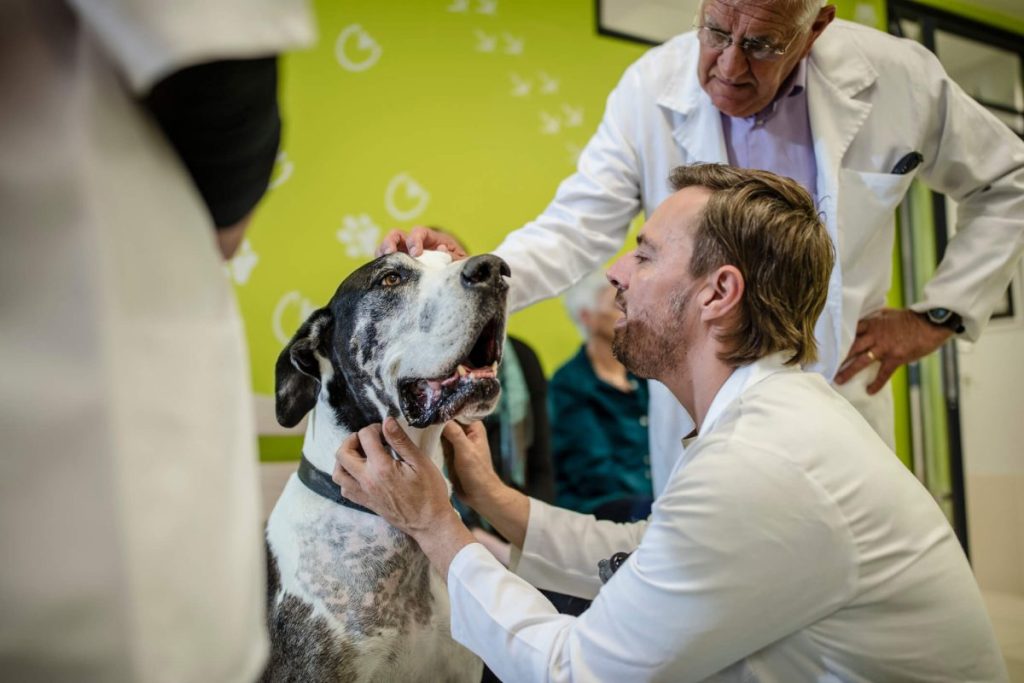Bone Cancer in Dogs: Symptoms, Causes, & Treatments

Bone cancer in dogs — also known as canine osteosarcoma — is a condition that results in an abnormal, malignant growth of immature bone cells or osteoblasts. It typically affects the long bones of the limbs, such as the femur, tibia, and humerus, but it can also occur in the skull, spine, ribs, and pelvis. This aggressive form of cancer can easily metastasize, meaning it can spread to other parts of the body, especially the lungs. Notably, osteosarcoma is the most common type of bone cancer in dogs, accounting for approximately 85% of all skeletal tumors.
Here’s what you should know about the symptoms, causes, and treatments for bone cancer in dogs.
Symptoms of bone cancer in dogs
The early signs of bone cancer in dogs can be subtle and easily mistaken for minor injuries or arthritis. Since osteosarcoma can develop in any bone — though most frequently in the long bones of the front legs — symptoms may vary depending on which bones are affected.
If you see the following signs, have your dog checked out by a veterinarian as soon as possible:
- Lameness or limping
- Swelling or a noticeable mass on the affected bone
- Pain and tenderness
- Reluctance to exercise or play
- Loss of appetite and weight loss
- Dehydration
- Tachycardia (rapid heart rate)
- Lethargy
- Fractures
In advanced cases, signs of metastasis may include respiratory difficulties if the cancer has spread to the lungs.
Causes of bone cancer in dogs

The exact cause of bone cancer in dogs is not fully understood, but it is believed to result from a combination of genetic and environmental factors. Certain genetic mutations and predispositions have been identified in some breeds, suggesting a hereditary component.
Male dogs tend to have bone cancer more often, as do canines who are spayed or neutered. Moreover, osteosarcoma typically affects middle-aged to older dogs, with a peak incidence in those between seven and 10 years old. However, it can also be seen in younger dogs, particularly those of rapidly growing large and giant breeds.
Breeds with a higher predisposition to osteosarcoma include:
- Rottweilers
- Great Danes
- Irish Wolfhounds
- Great Pyrenees
- Newfoundlands
- Bernese Mountain Dogs
- Saint Bernards
- German Shepherds
- Weimaraners
- Boxers
- Greyhounds
- Irish Setters
- Doberman Pinschers
- Golden Retrievers
Environmental factors such as previous bone injuries, fractures, and exposure to ionizing radiation may also contribute to the development of the disease.
Treatments for bone cancer in dogs

Before starting any treatment, your veterinarian will first conduct a series of tests to confirm the diagnosis and determine the stage of the bone cancer in your dog. These may include:
- Physical examination: Your veterinarian will assess your dog’s overall health and palpate the affected area for swelling or masses.
- Radiographs (X-rays): X-rays of the affected limb can reveal characteristic bone changes, such as bone destruction and new bone formation.
- Biopsy: A sample of the tumor tissue is collected and analyzed histologically to confirm the diagnosis of osteosarcoma.
- Advanced imaging: CT scans or MRIs may be used for detailed visualization of the tumor and to plan surgical interventions.
Once a diagnosis has been confirmed, the following treatment options may be considered:
- Surgery: Surgical intervention is typically the first line of treatment for osteosarcoma in dogs. The most common surgical option is amputation of the affected limb. While this may sound drastic, many dogs adapt very well to life on three legs and can return to a normal, pain-free lifestyle. In some cases, where amputation is not a viable option, limb-sparing surgery may be considered. This involves removing the cancerous section of bone and replacing it with a bone graft or metal implant.
- Chemotherapy: Chemotherapy is often used in conjunction with surgery to target any remaining cancer cells and reduce the risk of metastasis. Commonly used chemotherapy drugs include cisplatin, carboplatin, and doxorubicin.
- Radiation therapy: Radiation therapy can be an effective way to manage pain and slow tumor growth, especially if surgery is not an option. It targets the cancer cells directly, reducing tumor size and alleviating pain.
- Pain management: Managing pain is a critical component of the treatment plan. Your veterinarian may prescribe medications such as NSAIDs, opioids, gabapentin, and bisphosphonates to reduce pain.
Prognosis for bone cancer in dogs

The prognosis for dogs with osteosarcoma depends on several factors, including the tumor’s location, size, stage at diagnosis, and the chosen treatment regimen. If it is treated before it spreads, the chances of survival are better than if the cancer moves to the lungs, lymph nodes, or another part of the body.
Without treatment, the prognosis is poor, with a median survival time of four months due to the aggressive nature of the disease and rapid development of metastases. With proper treatment — such as amputation combined with chemotherapy — the median survival time can extend to 10-12 months. Approximately 20% of dogs may survive up to two years or longer post-diagnosis. Dogs undergoing limb-sparing surgery or palliative treatments have variable outcomes based on the effectiveness of pain control and the progression of the disease.
If your dog has bone cancer, it will be up to you and your vet to determine what is the most appropriate course of action. Osteosarcoma is often fatal, even with surgery and therapy, and many pet parents decide not to pursue treatment. Nonetheless, new procedures are always in development that may be less invasive and improve with time and research.
Receiving a bone cancer diagnosis for your dog can be overwhelming. Make sure to seek support from friends, family, or pet support groups. Understanding the treatment options and working closely with your veterinarian can make a significant difference. Remember, each dog’s situation is unique, and your vet will guide you through the best approach tailored to your pet’s specific needs. With the right care and attention, you can help your dog maintain a good quality of life for as long as possible.







